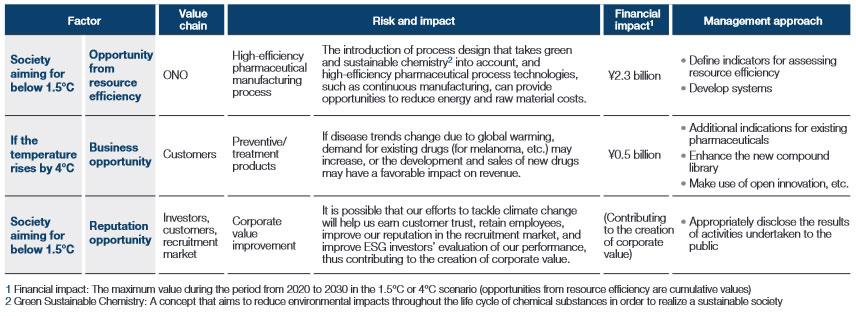Footnote
(Note 1) Abbreviation for International Energy Agency.
(Note 2) One of the Representative Concentration Pathways, a scenario in which the temperature is projected to rise about 4 degrees Celsius by 2100.
(Note 3) Abbreviation for Intergovernmental Panel on Climate Change.
(Note 4) Acute or chronic damage caused by disasters and other events caused by climate change and uncertain decarbonization policies.
(Note 5) In FY2020, flood/water shortage risk were analyzed at 3.4 billion yen and 0.0 billion yen, respectively, but the numbers were reduced in the revised analysis.
(Note 6) Risks resulting from the enhancement of decarbonization policies on a global scale (e.g. climate change policies/regulations, technology developments, market trends, changes in evaluations, etc., in the market)
(Note 7) The three priority items are Realization of a decarbonized society, Realization of a water recycling society, and Realization of a resource recycling society, and we set specific medium- and long-term targets for greenhouse gases, water, and resource recycling.
(Note 8) Prepared by ONO PHARMACEUTICAL CO., LTD. based on [Global average surface temperature change] of “Climate Change 2013: The Physical Science Basis – Summary for Policymakers” [IPCC, 2013, page 19]
Analysis and Evaluation of Risks and Opportunities Related to Climate Change
ONO PHARMACEUTICAL CO., LTD.
| Publication date | August 22, 2022 (Posted on April 26, 2023) |
|---|---|
| Sector | Industrial and economic activities / Water Environment / Water Resources |
Company Overview

Founded in 1717, ONO PHARMACEUTICAL CO., LTD. is an R&D-oriented pharmaceutical company specializing in the development of new drugs. We focus on the drug development in the areas of oncology, immunology, neurology, and specialties; all of which include diseases with high medical needs. We are actively engaged in the discovery of drugs that meet unmet medical needs, as well as the creation of new drugs by utilizing the technologies and expertise accumulated through our research to date.
Climate Change Impacts
In recent years, global environmental challenges such as climate change have become increasingly serious, and by 2050, various threats are expected to jeopardize the health and well-being of people, including water and food shortages, emergence of new diseases, and the destruction of the foundations of life due to the severity of natural disasters.
Adaptation Initiatives
Recognizing that our business activities are supported and existing by a s global environment and that it is our responsibility to enforce our efforts to resolve environmental challenges, we expressed our support for the recommendations of the Task Force on Climate-related Financial Disclosures (TCFD) in October 2019.
In the same year, a TCFD Working Group was established to analyze and evaluate risks and opportunities related to climate change based on TCFD recommendations, using the 1.5°C scenario in which a decarbonized society is progressing and the 4°C scenario in which global warming is intensified.
We used the Sustainable Development Scenarios by the IEA (Note 1) for the 1.5°C scenario, and the RCP8.5 Scenario (Note 2) by the IPCC (Note 3) and the Public Policy Scenarios by the IEA for the 4°C scenario (Fig. 1). The scope of analysis includes our domestic plants and contract manufacturers, suppliers, investors, customers, recruitment, etc. at home and abroad. The target period and area are FY2020-2030 and the pharmaceutical manufacturing industry, which is our major business, respectively.
The identified risks and opportunities will be annually reviewed, and in the risk assessment for climate change in FY2021 (Fig. 2), we reviewed the results of the FY2020 analysis on the impact of physical risks (Note 4), based on the changes in our product structure and suppliers. We reviewed the results of the analysis, and the analysis results for flood risk and water shortage risk were 2 billion yen and 0 billion yen, respectively (Note 5). We also confirmed the response status to the recognized risks. The amount of financial impact of transition risks (Note 6) was not revised, since there were no specific changes in the assumptions at the time of the calculation, and no changes were found for the opportunities related to climate change (Fig. 3).
Although the scenario analysis confirmed that neither scenario poses a significant financial risk to the company, we will continue to check trends in the international community and closely monitor the impact of risks and opportunities that may have a relatively significant financial impact.
Effects / Expected Benefits
In June 2019, we formulated our medium- to long-term environmental vision "ECO VISION 2050 (Note 7)", and we set “Realization of a decarbonized society” as one of our key priority items. Although the identification of risks based on TCFD recommendations is among those initiatives, we analyze the timing of occurrence, probability, extent of impact, and evaluate the details of countermeasures to comprehensively determine the level of priority in coordination with our company-wide risk management system.
For example, the water risk identified in the analysis regarding physical risks is addressed as one of the company-wide risks, disaster/climate change risk. So we implement measures based on our business continuity plan, such as maintaining proper level of inventory. Going forward, we will work to establish a cooperative relationship with our business partners, secure multiple suppliers, and consider the impact of floods/water shortages due to climate change in the process of selecting our business partners.

Fig. 1 Concept of climate change scenarios (Note 8)

Fig. 2 Risks related to climate change (FY2021)

Fig. 3 Opportunities related to climate change (FY2021)

